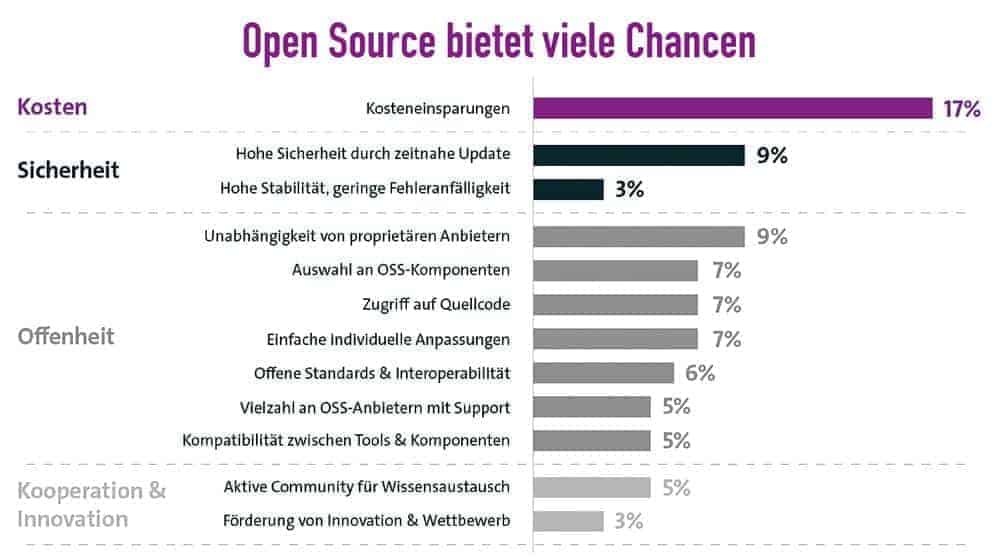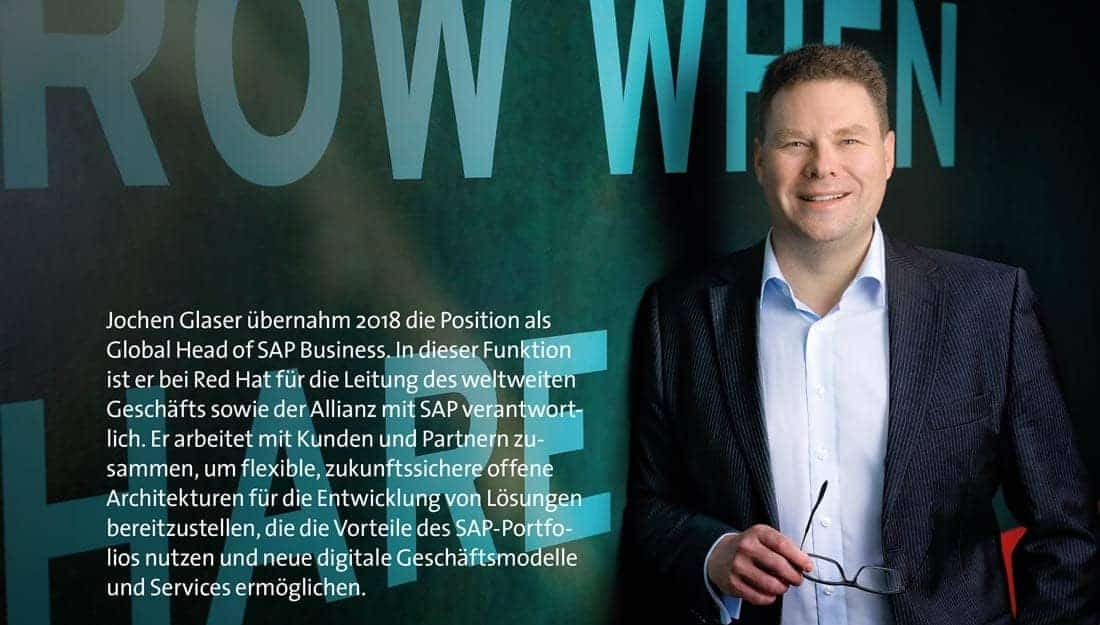Platform for E2E processes and digital excellence


Open source has arrived in the German economy! Two-thirds of larger companies already consciously use open source software. Only four percent view the topic critically or reject its use.
Thus, nine out of ten larger companies recognize the advantages offered by open source. Open source software is already used by the vast majority of larger companies in Germany - and the remainder could also make use of such freely available programs in the future.
This is the result of a survey of more than 800 companies with 100 or more employees in Germany commissioned by the digital association Bitkom.
"There are currently new challenges for existing SAP customers, as two fundamental IT initiatives are currently shaping the market: firstly, SAP modernization and secondly, the productive implementation of digital innovations and services."
is how Jochen Glaser focuses on the question of why open source and thus Red Hat are so successful in the SAP community.
"Both IT initiatives are happening simultaneously. This development requires new, common architectures and platforms instead of former silos."
Red Hat is helping build the new SAP architecture, end to end, and has been helping existing customers break down silos from days gone by.
"This also creates a lot of synergy effects."
knows the Global Head of SAP Business at Red Hat, Jochen Glaser, from many successful projects.
"Our portfolio includes around 50 solutions in the areas of IT optimization, agile integration, hybrid cloud infrastructure, cloud-native application development and automation.
All areas are also crucial elements for the SAP environments of the future. The goal is to give SAP users the freedom to choose a hybrid cloud architecture."
Bitkom surveyed that three quarters of companies describe themselves as interested in open source and open to the topic. Only four percent say they are fundamentally critical of or reject open source.
One in five companies is still undecided. And even today, only one in four companies with 100 or more employees say they do not use open source. Two-thirds, on the other hand, deliberately use open source software.
"Probably even many more companies use open source solutions without knowing it - whether as smartphone operating systems or as a software base for web servers"
says Bitkom President Achim Berg.
"Open source is especially crucial for new technologies such as artificial intelligence or blockchain, because the pace of development is particularly fast there."
A very special challenge can be found in the SAP community: From 2025, all SAP applications are to run on the Hana database, and Hana needs Linux.
"For many years and versions, Red Hat has delivered officially supported Linux platforms for SAP Hana."
explains Jochen Glaser.
"In the SAP environment, that's why a very large ecosystem of Red Hat partners - OEMs, GSIs or ISVs - globally use Red Hat Enterprise Linux as a platform for private, on-premise and public cloud offerings."
And Red Hat also offers, for example, a range of smart management tools and, based on Red Hat Ansible, automated SAP Hana deployments in any hybrid environment (see also the following page on Ansible Automation).
Red Hat positions and describes itself as follows: Red Hat delivers the right answers and solutions for the challenges of SAP users - based on a global ecosystem, a rich portfolio of products and services and, last but not least, by providing business know-how.
Red Hat's offering is also the result of many years of close cooperation between the market-leading open source platform provider and the leading business software vendor.
As early as 1999, Red Hat Enterprise Linux was running with SAP applications. Gradually, the cooperation intensified - from Red Hat Enterprise Linux 4, which was already SAP-certified, to Red Hat JBoss with SAP Hana porting agreement and integration with SAP NetWeaver, to Red Hat Enterprise Linux for SAP solutions and Hana.
Especially since 2017, Red Hat's offering for the SAP world has multiplied. The latest example is Red Hat Enterprise Linux 8 for SAP Solutions.
And what are Red Hat's plans from 2020? Where will the Red Hat focus be in the Hana environment?
"In short, freedom to choose the platform for current and future SAP workloads, no vendor lock-in in terms of cloud providers, and therefore full control for the SAP community"
Jochen Glaser is proud of his end-to-end offering.
"Red Hat holistically supports the SAP technology strategy "The Intelligent Enterprise". In concrete terms, these added values are based on a uniform core: Red Hat Enterprise Linux, RHEL, for SAP Hana is no different - and I want to emphasize this in particular - from the standard RHEL.
All certifications for hardware, software and security apply without restriction. All extensions, smart management products and automations from Red Hat's portfolio are identical, resulting in multiple synergies in terms of a unified open hybrid cloud infrastructure platform."
Bitkom knows that nine out of ten companies with 100 or more employees see advantages in using open source software. When asked about the most important advantage, 17 percent name cost savings, since no license fees are incurred.
These are followed at some distance by other reasons such as high security through timely updates and independence from individual software providers (9 percent each), as well as the broad selection of open source components, access to the source code and simple individual adjustments to the software (7 percent each).
In addition, open standards (6 percent), compatibility with other tools in use, and an active community for knowledge exchange (5 percent each) are seen as decisive advantages of open source.
"Companies have long used open source not just because it's free, but because it can offer many other benefits - from greater security to easy customization of software"
says Bitkom President Berg, who thus indirectly agrees with Jochen Glaser about the very pleasing trend. Glaser:
"Meanwhile, Red Hat supports much more than Linux for SAP. At our core, we provide a fully integrated open hybrid cloud infrastructure platform that the SAP community needs."
Red Hat seems to be the most successful open source company worldwide. Why has Red Hat been less aware of the SAP scene in recent years?
"This is a question that I really only hear from the German-speaking world."
Jochen Glaser is surprised.
"I don't think Red Hat has neglected the SAP scene, not even in Germany. We have always been very involved in the SAP community, and completely independent of the region.
We have been supplying certified Linux platforms for SAP environments since 1999. Red Hat is the world's leading open source provider and also the first choice as SAP Linux platform outside the German-speaking community."
The SAP community has a similar perception of Red Hat across all regions, as a leading open source vendor that has always been very committed to SAP.
But Jochen Glaser admits that indeed the German-speaking market is somewhat of an exception.
"But even here at home, our commitment to SAP and the SAP community is unwavering"
he emphasizes.
Nevertheless, there are reservations, as Bitkom has surveyed: Eight out of ten larger companies (79 percent) also see disadvantages in the use of open source. Twelve percent say the biggest disadvantage is the lack of specialists, i.e., experts in the company, to adapt the software to individual needs and develop it further, for example.
This is followed by a lack of acceptance within the company (7 percent), an unclear warranty situation, a lack of training courses, a lack of solutions for the company's own use case, the time-consuming conversion from the previous software to open source, and an overly large and thus unmanageable selection of open source solutions (6 percent each). Five percent also complain about the high training and familiarization costs.
Particularly in the SAP community, these concerns apply only to a limited extent, Glaser knows:
"There are many benefits in the Red Hat offering, for example, extended long-term support options, proactive monitoring, and resolution to SAP specifications, i.e., SAP Notes.
All variants are of course highly available. Red Hat Ansible, as part of the operating system, allows automated SAP Hana deployment within just a few minutes - and exactly according to SAP Notes specifications.
In addition, a certified API management connection to Hana allows modernization and migration of in-house developments in S/4 projects, in addition to new services."
The SAP Hana scene is confronted with a paradox: The best on-prem server for Hana is Power 9 and comes from IBM, the associated Linux operating system comes from Suse, but the logical choice would be Red Hat because this company belongs to IBM. What now?
"Red Hat and IBM share a common hybrid cloud strategy. The necessary technology components are based on the Red Hat Open Hybrid Cloud Infrastructure."
explains Jochen Glaser.
"Following the recent announcement of the transition of all IBM Cloud Pak offerings to Red Hat OpenShift and Red Hat Enterprise Linux, IBM has decided to also use Red Hat Enterprise Linux as the platform for Hana on IBM Power. We expect official SAP certifications for Red Hat Enterprise Linux 8 on IBM Power 9 for Hana shortly."
There is an institutionalized and extremely close collaboration between SAP and Red Hat. Global alliance responsibility for the partnership is based in Wall-dorf.

The collaboration takes place on a wide variety of levels. Among other things, there is SAP support training at Red Hat, plus global training and partner enablement resources for the really very large Red Hat SAP Eco system.
"We also have a presence at the SAP Partner Port in Walldorf, the SAP Linux Lab, and a number of strategic SAP partners, integrators and ISVs.
Red Hat is also a member of the SAP Benchmark Council. So our commitment to SAP is really extremely comprehensive and multi-layered".
Glaser describes the current situation with pride.
Jon Dorrington is VP of SAP Global Business Development and Global Ecosystem and says:
"Red Hat is a strategic and valuable open source partner to SAP. Red Hat's technology leadership in Linux, container orchestration and API management helps drive new joint innovation opportunities between us and our mutual customers."
He further emphasizes:
"Recently, we completed the definition of a new strategic alliance with Red Hat. It expands the platform offering and enhances the support portfolio around the flagship operating system RHEL for SAP Solutions."
What's planned for the future? SAP CEO Bill McDermott likes to use "cloud first." What cloud offerings does Red Hat have for SAP's existing customers?
"Red Hat's global open hybrid cloud strategy based on open source goes hand in hand with the alignment of SAP and, representing the ecosystem of all partners, IBM as well"
knows Jochen Glaser.
The goal is application development that is anchored and simplified in the platform, strategic flexibility in the selection of underlying resources, and a DevOps capability also for SAP workloads and beyond.
Jochen Glaser explains specifically:
"A majority of SAP users will want to use a mix of on-premise, private cloud and public cloud services in the long term, for both SAP and non-SAP workloads that are tightly integrated with each other.
All three tiers - including on-premise - can be uniformly mapped with Red Hat OpenShift as a proven enterprise Kubernetes platform. There is no need for separate development for on-premise or even for individual public cloud platforms.
And SAP's ecosystem benefits as well. Over 200 certified third-party solutions are already in Red Hat's container catalog today."







